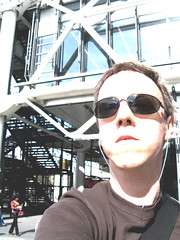The Social Hyperspace
The Transformative Technology paper is done and dusted, and off for compilation into the electronically-published proceedings of the Cybercultures 2005 conference. The last paragraph of the paper is for me the one that interests me most in terms of exploring this further:
While the paper is written from the context of creative practice, I'm much more broadly interested in the transformative effects of technology as it moves beyond appliance-centred and performance-driven modes. Some of the effects of this are visible today in Web 2.0 oriented services and the variegated, richly-textured and densely-layered social web that's emerging from the interweaving of what Mike Priddy refers to as our personal hyperspaces and the oft-derided but still advancing collapse of distance (or, at least, the tendency of latency towards the asymptote). To put it plainly, though the coming of me-dia (Negroponte's Daily Me) was meant to shatter social cohesiveness we seem to have been remarkably adept at using technologies to create a new, and much more complex, form of commons. My networks overlap some of yours, and a url (or increasingly an automated aggregator) is all it takes to clue you into something that I want to share. The move from broadcast simultaneity to podcast/Tivo timeshifting doesn't seem to have reduced the likelihood of us having heard the same show: If anything the dramatically-improved opportunity for access and the multiplying of the available forms for the same content seem to have made it more likely that we're on the same page (though we might get there at different times, and by different routes).
In practical terms I'm hoping that we can begin to get into the detail of how applications and services are beginning to reflect this transformative stage of technology. I think that before we begin the next paper (Mike and I still plan to develop the abstract that we submitted to League Of Worlds in Melbourne despite not hearing anything back) I'll be working up an article around some of the best examples of the emerging nodes on this emerging social hypernetwork.
Kurzweil's Law of Accelerating Returns inevitably creates dramatic effects which will begin to be felt more widely within creative practice as the curves of technological advances progress beyond their initial stages. While these effects are by their very nature unpredictable, we might reasonably expect them to be characterised broadly by a displacement of existing centres of power in the creative industries, by the further breakdown of the defined roles of artist/producer/distributor/consumer, and by the sudden rise and fall of new forms which evolve and propagate in net-time, mutating and sometimes disappearing literally overnight. We have been conditioned to consider the possibility of "Business at the Speed of Thought", yet we are still encouraged to view serious creativity as a more measured and mediated activity. Given the personal panopticon, the supernetworks, and tera-transaction computing, the ability for new kinds of information/software/media/art to coalesce around the sudden requirements of micro-communities will transform how we think about production, and create vehicles for creativity at the speed of ideas themselves.
While the paper is written from the context of creative practice, I'm much more broadly interested in the transformative effects of technology as it moves beyond appliance-centred and performance-driven modes. Some of the effects of this are visible today in Web 2.0 oriented services and the variegated, richly-textured and densely-layered social web that's emerging from the interweaving of what Mike Priddy refers to as our personal hyperspaces and the oft-derided but still advancing collapse of distance (or, at least, the tendency of latency towards the asymptote). To put it plainly, though the coming of me-dia (Negroponte's Daily Me) was meant to shatter social cohesiveness we seem to have been remarkably adept at using technologies to create a new, and much more complex, form of commons. My networks overlap some of yours, and a url (or increasingly an automated aggregator) is all it takes to clue you into something that I want to share. The move from broadcast simultaneity to podcast/Tivo timeshifting doesn't seem to have reduced the likelihood of us having heard the same show: If anything the dramatically-improved opportunity for access and the multiplying of the available forms for the same content seem to have made it more likely that we're on the same page (though we might get there at different times, and by different routes).
In practical terms I'm hoping that we can begin to get into the detail of how applications and services are beginning to reflect this transformative stage of technology. I think that before we begin the next paper (Mike and I still plan to develop the abstract that we submitted to League Of Worlds in Melbourne despite not hearing anything back) I'll be working up an article around some of the best examples of the emerging nodes on this emerging social hypernetwork.
Technorati Tags: Creativity, Hyperspace, Internet, Networks, podcasting, Social Networks, technology, Transformative, Web, Web 2.0


0 Comments:
Post a Comment
<< Home